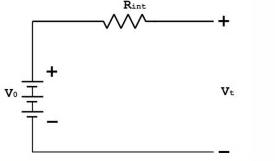Warning: The following explanation is very simplified, perhaps overly so. However, it is a reasonable first approximation way of thinking of it.
The SCC, Battery and Load are all in parallel.

If the voltage of the SCC is greater than the battery, it will drive current into the battery. For this case, we can think of the battery as a resister with an effective resistance that is a complex factor of the battery SOC and the voltage being applied to it. As these variables change, the effective resistance will change. Increasing voltage at the terminals and increasing SOC will both cause the effective resistance to go up. (This is an extreme simplification, but it works for the purposes of this discussion.)

So, for a given voltage from the SCC, there will be Vscc/Rload going into the load and Vscc/Rbatt going into the battery. This model works for an given snapshot in time, but as you will see below, it does not work over a period of time because the Rbatt is not a constant.
Now lets imagine the Load increases. This would mean Rload goes down and the current going through it will go up. As long as the SCC can supply the extra current without affecting its voltage, the current into the battery will not change. If the SCC voltage starts to go down due to the load, the current into the load will go down in a linear fashion defined by Iload = Vscc/Rload. However, since the effective resistance of the battery changes with the voltage on the terminal, the lower voltage will actually result in a higher effective resistance through the battery. Consequently, the reduction in current to the battery is a non-linear function of the charge controller voltage. Consequently, the current through the battery will go down faster than the current through the load. This will continue till the SCC voltage = the battery voltage. At that point the effective resistance of the battery is infinite and all the current is going through the load.

Continuing the thought exercise, let's go back to when the current is flowing into both the load and battery. Over time, the SOC of the battery will go up, causing the effective resistance to go up as well so the current into the battery will go down. Eventually, the SOC reaches 100%, the effective resistance of the battery will again be infinite and the current into the battery will go to zero. However, the SCC can still be providing current to the load.
Meanwhile, this is all complicated by the fact that the SCC is not a linear device either. In its bulk mode, it will pump as much current into the system as it can. During this time, it will make the voltage as high as it can up to the preset charge voltage. Once the system hits the preset charge voltage, the SCC will hold that voltage by reducing its output current. As the battery charges up, it will take less and less current till the SCC is only supplying enough current to drive the load at the preset voltage.
I hope this helps. I tried to simplify the concepts but when I read back over it I am not sure I accomplished the goal









